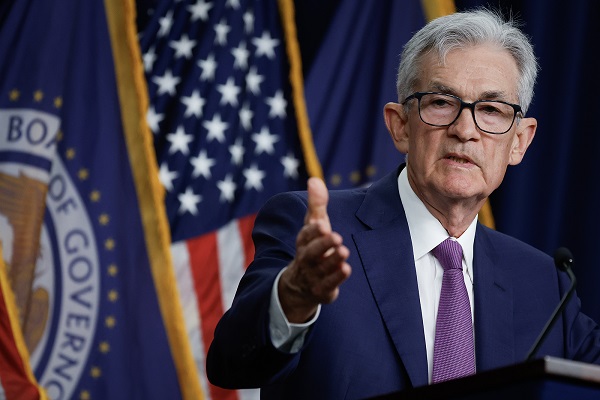economy news online
By Craig Torres
Bloomberg News
(Bloomberg News) The Federal Reserve signaled fresh concerns about inflation while indicating it was likely to keep borrowing costs elevated for longer rather than raising them again. news online
Officials unanimously decided Wednesday to leave the target range for the benchmark federal funds rate at 5.25% to 5.5% — where it’s been since July — following a slew of data that pointed to lingering price pressures in the U.S. economy. They also reaffirmed the need for more evidence that price gains are cooling before cutting interest rates from a two-decade high.
“So far this year, the data have not given us that greater confidence in particular” that rate cuts are appropriate, Chair Jerome Powell said at a press conference following the two-day meeting in Washington. “Readings on inflation have come in above expectations. It is likely that gaining such greater confidence will take longer than previously expected.”
Powell said it’s unlikely that the Fed’s next move would be to raise interest rates, saying officials would need to see persuasive evidence that policy is not tight enough to bring inflation back toward the central bank’s 2% target. “We don’t see evidence supporting that conclusion,” he added.
Those remarks soothed investors who had worried the Fed might react more aggressively to signs that inflation progress has stalled. Stocks and Treasuries rose, and futures markets showed a slightly greater chance policymakers will lower rates twice this year, instead of the one cut expected before the meeting.
Still, Powell stopped short of signaling rate cuts were likely this year or that rates were at a peak, which he has said previously.
economy news online
In a statement Wednesday at the conclusion of the meeting, the Federal Open Market Committee said in “there has been a lack of further progress toward the committee’s 2% inflation objective” in recent months. That represented an addition to phrasing introduced in December saying that inflation “has eased over the past year but remains elevated.”
In another change, the Fed said that risks to achieving its employment and inflation goals “have moved toward better balance over the past year,” referring to the progress in the past tense. The previous statement said the goals were “moving into better balance.”
(Please click onto the image of the cat to hear Oldies & Classic Rock)

Officials also outlined plans to slow the pace at which the central bank is shrinking its asset portfolio. The Fed will cut the cap on runoff for Treasuries to $25 billion a month from $60 billion beginning in June, in a bid to reduce the risk of financial-market turbulence that struck during the previous round of balance-sheet trimming in 2019.
The cap for mortgage-backed securities remained unchanged at $35 billion, though the Fed will in June reinvest any principal payments above the cap into Treasuries instead of MBS.
On the balance sheet, policymakers generally agreed at the Fed’s previous meeting in March that it would be appropriate to take a cautious approach toward further runoff — a process known as quantitative tightening, or QT — given market turmoil in 2019, minutes from the meeting showed.
economy news online
Officials have stressed that the decision to slow QT is independent of rate cuts and their timing.
Inflation roadblock
While price pressures cooled rapidly in the final months of 2023, progress toward the central bank’s 2% inflation goal has stalled in 2024. Meantime, the economy continues to expand on the back of a strong labor market and steady consumption and investment.
Wednesday’s statement reiterated that job gains have “remained strong” with a low unemployment rate, while the economy has expanded at a “solid pace.”
Data out Tuesday showed employment costs climbed in the first quarter at the fastest pace in a year, topping expectations and pointing to robust wage growth.
Three straight months of disappointing inflation figures have driven a major repricing of interest-rate expectations, with futures markets now showing just one cut this year.
That’s well below the three narrowly projected by Fed officials in March and the roughly six anticipated by markets at the start of 2024. Concerns that the central bank may not cut at all this year have also grown amid questions of just how much Fed policy is restraining the economy.
Against a backdrop of a resilient economy, the pickup in prices has also led to a change in tune among Fed officials. The rate cuts signaled by Powell in December relied heavily on a continued deceleration in inflation — something that hasn’t happened.
As a result, Powell said in April that it would likely take “longer than expected” to gain the level of confidence on inflation’s trajectory needed to lower interest rates. He added the central bank can keep rates steady for “as long as needed.”
The Fed’s preferred price gauge was up 2.7% in March from a year earlier, an acceleration from the prior period. Excluding food and energy, it advanced 2.8%.
(With assistance from Kristy Scheuble, Alex Harris and Liz Capo McCormick.)
©2024 Bloomberg L.P. Visit bloomberg.com. Distributed by Tribune Content Agency, LLC.
economy news online
Notes from APS Radio News
Reportedly because of what was being called a “pandemic”, a number of the world’s central banks embarked on massive programs of monetary expansion, starting in late February and early March of 2020.
For its part, between the early part of March of 2020 to over a year later, the US Federal Reserve added over $4 trillion to its holdings, by purchasing billions of dollars’ worth of Treasury bonds and corporate bonds each month during that period.
As well, at that time it kept interest rates rather low.
Other central banks, including the Bank of Japan and the European Central Bank, followed similar policies.
In addition, during that period many countries engaged in lockdowns; many small and medium-sized businesses and enterprises were shuttered by way of orders issued by public health officials, politicians and various administrators.
One of the direct causes of those shutdowns was the development of shortages.
According to a number of economists, the combination of shortages of various goods and services and massive programs of “quantitative easing” led to substantially higher rates of inflation.
In consequence of shuttered economies and higher rates of inflation in the first world, less developed countries suffered greatly, due, in part, to shortages of supplies and due to lowered demand.
For some time, in its articles about China, The Wall Street Journal has pointed to “covid” related lockdowns as being one of the major causes of China’s downturn in its economy.
In the US, by October of 2020, over 100,000 businesses had been shuttered by way of lockdowns.
economy news online


